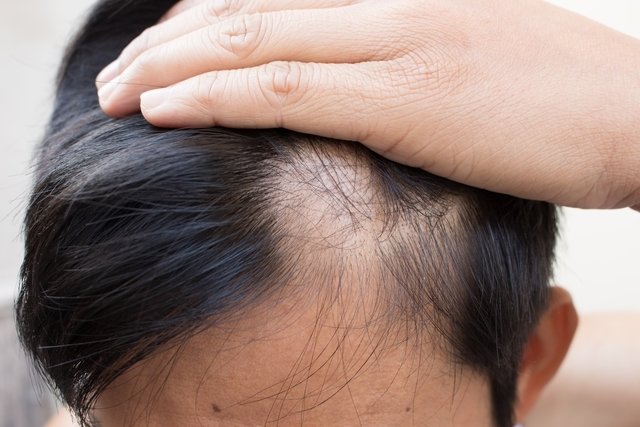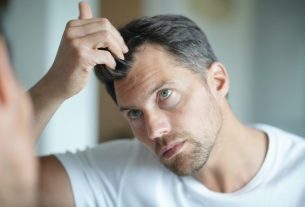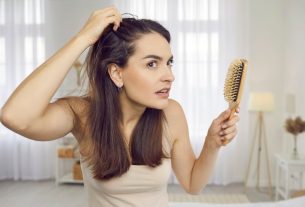Alopecia is a condition characterized by the loss of a large amount of hair from the scalp or hair from any other region of the body, exposing the scalp or skin that was previously covered by hair or fur.
Hair loss can have several causes, such as stress, autoimmune diseases or thyroid changes. According to the cause of this condition, alopecia can be classified into several types, the most common of which are alopecia areata, androgenic alopecia and telogen effluvium.
Treatment for alopecia is carried out according to the cause, however, in most cases the hair loss is treated with the use of medications that are applied directly to the affected area and which must be recommended by a dermatologist.

Main symptoms
The main signs and symptoms of alopecia are:
- Loss of more than 100 strands of hair per day, noticed when finding many strands on the pillow when waking up, when washing, combing or running your hands through your hair;
- Thinner hair strands;
- Presence of areas, on the scalp or beard, with little or no hair or hair.
Although it occurs mainly on the head, signs of alopecia can be noticed in any area of the body with hair, such as the beard, eyelashes, eyebrows, nose hair and pubic hair.
How to confirm the diagnosis
The diagnosis of alopecia must be made by a dermatologist based on an assessment of the scalp or skin.
If you want to assess your risk of alopecia, make an appointment with the dermatologist closest to you:
Taking care of your health has never been easier!
To confirm the diagnosis, the doctor can also collect hair from the region or a small sample from the scalp so that a more detailed assessment can be carried out and, thus, the cause of the alopecia can be identified.
Possible causes
Alopecia can occur due to several situations, the main ones being:
- Ringworm on the scalp;
- Use of medications;
- Stress;
- Postpartum hormonal reaction;
- Use of inappropriate chemicals;
- Systemic lupus erythematosus;
- Diseases such as hypothyroidism, hyperthyroidism, secondary syphilis or lichen planus;
- Deficiency of proteins, iron, biotin and zinc.
Furthermore, some types of cancer can also promote hair loss, such as skin cancer, for example.
Types of alopecia
Alopecia can be classified into some types according to the cause of hair loss:
1. Alopecia areata
Alopecia areata is caused by autoimmune diseases, genetic factors, thyroid or emotional changes, characterized by loss of hair and hair in other regions of the body, resulting in the appearance of round plaques on the scalp with no hair.
Read too: Alopecia areata: what it is, symptoms, causes and treatment
2. Androgenetic alopecia
Androgenetic alopecia, popularly known as baldness, is caused by an abnormal response of hair follicles on the scalp to androgen hormones such as dihydrotestosterone due to a genetic predisposition. Find out how to identify baldness.
Androgenetic alopecia can occur in men, known as male androgenetic alopecia, and is noted by increased hair growth on the forehead and top of the head.
In women, alopecia, which is known as female androgenetic alopecia, commonly affects the front part of the scalp, where thinner and thinner hair can be seen, but without altering the hair growth line on the forehead. See the signs of female androgenetic alopecia, or baldness, in women.
3. Traction alopecia
Traction alopecia is caused by the habit of styling your hair too tightly, such as braids and ponytails, and is more common in women who undergo chemical procedures, such as straightening and coloring, for example.
Traction alopecia causes inflammation and the appearance of signs such as redness and flaking in the region, the appearance of small lumps and hair loss.
Read too: Traction alopecia: symptoms, causes and treatment
4. Alopecia frontal fibrosante
Frontal fibrosing alopecia, or cicatricial alopecia, is a condition that causes hair loss on the front and sides of the scalp, and can also affect hair on other parts of the body, such as the eyebrows.
This type of alopecia is caused by genetic predisposition and hormonal changes. Furthermore, contact allergy or allergy to cosmetics, moisturizing creams, hair dye and sunscreen are other possible causes of this type of frontal fibrosing alopecia.
5. Telogen effluvium
Telogen effluvium is a type of alopecia characterized by increased hair loss, where the person can lose more than 300 strands per day, with the appearance of regions of the scalp with little or no hair. Learn more about telogen effluvium.
This condition can be caused by situations such as stress, anxiety, hormonal changes or infections. Additionally, some people who have had COVID-19 may also have telogen effluvium after infection with SARS-CoV-2. Some studies indicate that this hair loss is related to an increase in pro-inflammatory cytokines in the body, in addition to stress, anxiety and/or high fever that are common during this period.
6. Seborrheic alopecia
Seborrheic alopecia is caused by dermatitis and is associated with other symptoms such as redness, itching and peeling of the scalp.
Read too: Seborrheic dermatitis: what it is, causes, symptoms and treatment
How the treatment is carried out
Alopecia treatment varies depending on the causes of this condition, including oral and topical medications, hair transplants, supplements and aesthetic treatments.
1. Oral medications
Oral medications, such as finasteride and spironolactone, may be recommended by the doctor in cases of traction alopecia, androgenetic alopecia and telogen effluvium, to stimulate healthy hair growth and delay hair loss.
In severe cases of alopecia areata, the doctor may recommend the use of corticosteroids and immunosuppressants. Check out other medications recommended for hair loss.
2. Topical medications
Topical medications, such as minoxidil, finasteride and alfaestradiol, may be recommended by the doctor to promote hair growth and prevent hair loss, in cases of alopecia areata, androgenetic and scarring.
3. Supplements
The use of dietary supplements, containing B vitamins, iron, zinc and vitamin A, for example, may be recommended by the doctor to complement the treatment, as they help in the treatment of hair loss caused by nutrient deficiency.
4. Aesthetic treatments
Carboxytherapy is an aesthetic treatment performed by applying carbon dioxide under the skin to help the growth of new hair strands, as it stimulates increased blood flow to the scalp.
Hair mesotherapy is a technique where injections with vitamins, amino acids, corticosteroids and/or minoxidil are applied, for example, to promote hair growth, and can be recommended in cases of alopecia areata and cicatricial, for example.
Read too: Hair mesotherapy: what it is, how it is done and when it is indicated
5. Hair transplant
Hair transplantation is a surgery where the person’s own hair is removed to be transplanted into regions that do not have hair, and may be indicated in cases of androgenetic, frontal fibrosing or traumatic alopecia, for example. Understand better what hair transplantation looks like and how it is performed.
Is alopecia curable?
Some types of alopecia, such as seborrheic and telogen effluvium, can be cured when diagnosed and treated appropriately by a dermatologist. However, there is no cure for androgenetic and frontal fibrosing alopecia areata.
Read too: Is alopecia curable? 6 treatment options
How to prevent alopecia
Some tips that can help prevent some types of alopecia are:
- Maintain a healthy diet, prioritizing fruits, vegetables, whole grains, legumes and proteins;
- Reduce stress by doing activities that promote relaxation, such as yoga, meditation, running and dancing;
- Avoid hairstyles that hold your hair tightly, such as buns, ponytails or braids;
- Brush and comb your hair gently;
- Avoid using chemical products on your hair;
- Quit smoking, as smoking causes inflammation throughout the body, including the scalp.
However, it is important to remember that there is no prevention for alopecia caused by genetic predisposition, such as androgenetic alopecia, frontal fibrosing and areata.

Sign up for our newsletter and stay up to date with exclusive news
that can transform your routine!
Warning: Undefined array key "title" in /home/storelat/public_html/wp-content/plugins/link-whisper-premium/templates/frontend/related-posts.php on line 12
Warning: Undefined array key "title_tag" in /home/storelat/public_html/wp-content/plugins/link-whisper-premium/templates/frontend/related-posts.php on line 13



